|
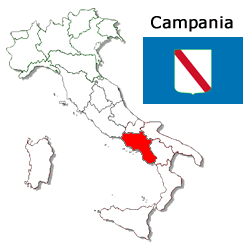 Information on Campania - Italy Information on Campania - Italy
 Avellino Avellino  Benevento Benevento  Caserta Caserta  Napoli Napoli  Salerno Salerno
Central Italy (est. pop. 5,191,731) 5,249 sq mi (13,595 sq km). Located on the shin of Italy's boot, The cuisine of Campania and Naples is famous thoughout the world.
Spaghetti with tomatoes and basil. Spaghetti Vongole, pizza topped with mozzarella, stuffed tomatoesand eggplant parmigiana. As well as fresh mozzarella made from buffalo or cow's milk, there is good ricotta, goat cheeses and caciocavallo. Lemons are used in granita and limoncello.
Wherever you go in this region, Mt. Vesuvius casts a dramatic shadow over the fertile landscape. Thanks to the volcanic soil, Campania yields some of the best fruits and vegetables in Italy. It stands to reason that many of Campania's dishes revolve around its delicious bounty of vegetables, particularly the prized San Marzano sweet plum tomatoes.
The area is also well known for its cheeses, including mozzarella, scamorza, provolone, caciocavallo, and pecorino. With that combination, it's no wonder pizza is another of this region's famous culinary contributions.
Naples, the region's densely-populated capital, is alive with movement, with bikes whizzing by and hands flying in exaggerated movements. Neapolitans will engage nearly anyone in conversation and they love to interact almost as much as they love to eat outdoors.
With the exception of the region's luscious fruit, sweets are usually reserved for special occasions. They're typically rich and elaborate, incorporating cream, ricotta, and dried fruit. Wine has been made here since the thirteenth century, and those that are produced in Campania are designed to be consumed right away.
Everyone has some knowledge of Neopolitan cuisine because it has been promoted around the World. Just think of pizza! But there are also many other recipes we all know which originated in Naples. There are recipes for Struffoli and Zeppole in the dessert section. These recipes are the most frequently requested.
 We welcome inquiries for available accommodations for the region of Campania and surrounding areas. Contact us for listing requirements. (Hotels - Motels - Villas - Bed & Breakfast - Condo Rentals, Agriturismo & all related accommodations) We welcome inquiries for available accommodations for the region of Campania and surrounding areas. Contact us for listing requirements. (Hotels - Motels - Villas - Bed & Breakfast - Condo Rentals, Agriturismo & all related accommodations)
Information:
 Regione Campania official site Regione Campania official site
|
| |
Avellino
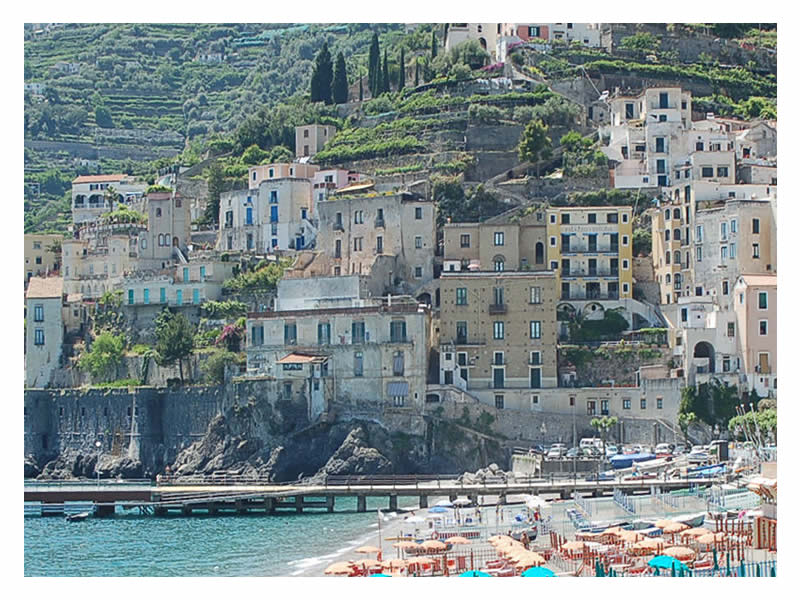 Avellino is situated over the green valley crossed by the Sabato river and surrounded by the Pertenio, Avella and Picentini mountains. Today it is mostly a modern town because of the massive reconstructions after the frequent earthquakes. The chestnuts and nuts factories are of great importance as well as the wineries producing the famous Fiano di Avellino, Aglianico, Greco di Tufo and Taurasi wines. The beauty of the nature and the many archeological and cultural sites attract many tourists to the area. Avellino is situated over the green valley crossed by the Sabato river and surrounded by the Pertenio, Avella and Picentini mountains. Today it is mostly a modern town because of the massive reconstructions after the frequent earthquakes. The chestnuts and nuts factories are of great importance as well as the wineries producing the famous Fiano di Avellino, Aglianico, Greco di Tufo and Taurasi wines. The beauty of the nature and the many archeological and cultural sites attract many tourists to the area.
 What to taste: What to taste:
• Due to the distance from the sea it's no wonder that meat, especially ovine and pork are a standard in that territory. What you traditionally see is the following delicacies: 'capocollo', 'soppressata', bacon and the 'fiocco di prosciutto'.
• The cheese production is also outstanding, thanks to the Because milk is substancial in the area cheese production is great obtained by the Laticauda and Bagnolese sheep: We get the following cheeses, Pecorino Carmasciano (still prepared traditionally), Pecorino Bagnolese (with its slightly hot aftertaste), Ricotta Laticauda (fresh and light but with a strong milky flavor) to mention a few.
•
The cold cut meats and cheeses go well with a slice of the Irpinian bread made in a traditional fashion and also the breads from Calitri, Iurmano and Montecalvo unique shape, smell and flavor.
• 'Peperone Quagliettano', 'cipolla ramata' and Montoro's artichoke, Volturara Irpina's beans are some of the best examples of the characteristic products of this land. Flavors that are exquisite when eating a bean soup with the 'friselle', a 'ciambottella', or the Santa Lucia's 'cicci'.
• As far as desserts are concerned, the area is famous for its 'torrone', dressed with the local hazelnuts or chestnuts. The crumbly 'spantorrone' is wrapped in sponge cake dipped in rhum and Strega liquor.
• The excellent extra-virgin olive oil is the main ingredient of the local cuisine, which also offers three great wines: the Taurasi, with an intense smell but smooth flavor, the Greco di Tufo, fruity with a slight almond aftertaste, and the Fiano di Avellino, protected and guaranteed by the DOCG label.
 Cities & Towns: Cities & Towns:
 More info her on all the Municipalities, Cities, Towns and Villages - Avellino More info her on all the Municipalities, Cities, Towns and Villages - Avellino
 What to do: What to do:
• Trekking, hiking and mountain biking are great ways to explore the natural evironment throughout the Apennine area.
• The mountains covered by beech and conifer woods, a popular summer destination for those who seek a holiday in the quiet of an untouched environment.
• Cervialto, Raiamagra, Cervarolo, Montagna Grande and Piscacca have mountain peaks with extraordinary views, ideal for the taking pictures.
• The mountains also offer many opportunities for alpine and cross-country skiing, as well as ice climbing.
• Cave adventurers should visit the Grotta del Caliendo, an underground world to explore.
 Places to visit: Churches, Museums, Ruins, Piazzas, Fountains, Places to visit: Churches, Museums, Ruins, Piazzas, Fountains,
• Avellino, the province seat, has maintained the small old village despite the tragic earthquake, with narrow streets along which one finds the Clock Tower, the Cathedral and the Castle, symbols of the city.
On the Partenio Mountain there is the Montevergine Sanctuary, which can be reached walking up a road that is worth the effort for the rewarding views. As the hike continues, the panorama opens on the whole valley and, on sunny days, all the way to the sea.
• The medieval castles that overlook the villages of the province, then defense buildings that, in some cases, have been transformed in residences during the Renaissance.
Among them, the Montemiletto's Castle of the Leonessa, one of the best preserved of the Avellino area, the Lauro's Lancellotti Castle, completely restored in the second half of the 19th century, and Ariano Irpino's Castle, which dominates the town from a strategic, almost inaccessible position.
 Events: Events:
• Coming soon.
 Tours avaiable in the region: Tours avaiable in the region:
 Accomodations in close proximity: Hotels, Restorts, Holiday Houses, Condo Rentals, Farm Holidays (Agritourismo), Accomodations in close proximity: Hotels, Restorts, Holiday Houses, Condo Rentals, Farm Holidays (Agritourismo),
|
|
| |
Benevento
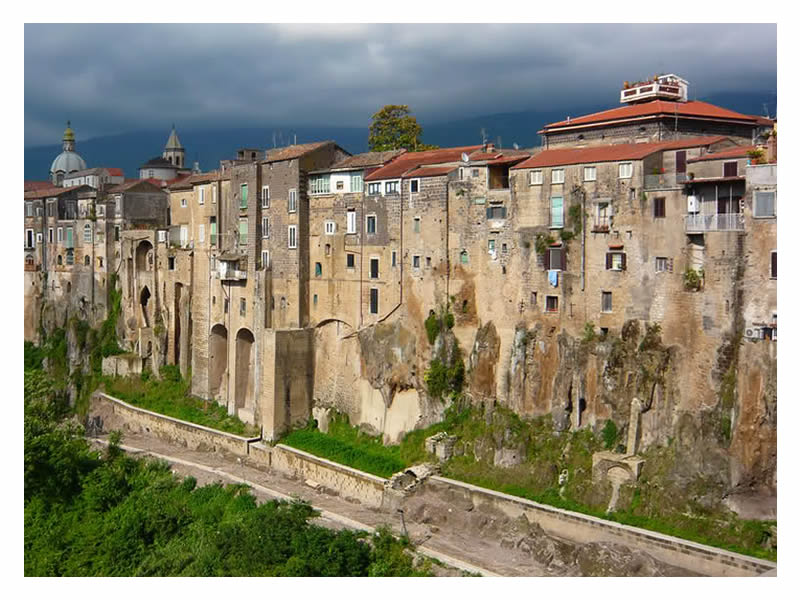 Benevento , city (1991 pop. 62,561), capital of Benevento prov., in Campania, S Italy. It is a trade center for wine and tobacco. It is basically an impoverished area with little industry. A leading town of Samnium, Benevento became under the Romans an important trade center on the Appian Way. Benevento , city (1991 pop. 62,561), capital of Benevento prov., in Campania, S Italy. It is a trade center for wine and tobacco. It is basically an impoverished area with little industry. A leading town of Samnium, Benevento became under the Romans an important trade center on the Appian Way.
Benevento is a province filled with history, archeological wonders and breathtaking landscapes. It is like looking back hundreds of years with the original architecture and roads from yesteryear.
It was the capital of a powerful Lombard duchy (6th-11th cent.) that extended over much of S Italy. Except for short periods of foreign occupation, the city was under papal rule from the 11th cent. to 1860. In 1266, Charles of Anjou defeated Manfred, King of Sicily, near Benevento. Noteworthy structures of the city include the cathedral (11th-13th cent., restored after being severely damaged in World War II); a triumphal arch erected (AD 114) for Trajan; a Roman theater (2d cent. BC); and the Church of Santa Sofia, with a 12th-century cloister.
 What to taste: What to taste:
• These are the following ingredients used in a tradtional kitchen in Benevento, extra-virgin olive oil, fresh handmade pasta, beef, sheep and pork meat, cheese, honey, fruit, walnuts and chestnuts.
• Pasta, soup, eggs, cheese and sausage pie, thistle soup, grilled meat, stuffed mushrooms, vegetable in oil, biscuits and the maize bread.
• The famous 'torrone', which was produced already by the Romans and was considered the typical dessert.
Torrone is a traditional nougat made with nuts, honey and egg whites produced throughout the Benevento province. There are countless varieties of this sweet treat to suit all palates, from hard to chewy, white or chocolate and made with a variety of nuts. Torrone is a classic Christmas candy in Italy, but in Benevento it can be enjoyed any time of the year.
• Liquore Strega, one of Italy's most famous liqueurs, has been made in Benevento by the Alberti Family since 1860. Words fail to describe this unusual yellow liqueur with its secret recipe of over 70 different herbs and spices so be sure to taste Benevento's specialty for yourself. Drink by the glass or in one of the local desserts or chocolates made with Strega.
• These are the local wines: Solopaca, Aglianico del Taburno, Falanghina, Beneventano and Dugenta are names of local DOC and IGT productions.
 Cities & Towns: Cities & Towns:
 More info her on all the Municipalities, Cities, Towns and Villages - Benevento More info her on all the Municipalities, Cities, Towns and Villages - Benevento
 What to do: What to do:
• The Camposauro Adventure Park challenges the whole family on a series of trails that require the aid of ropes, pulleys, bridges and ladders; it is an alternative way to have fun and to test one's abilities.
• Very interesting, also from an archeological standpoint, is the climb to Monte Acero whose top once was enclosed by a massive wall now still standing.
• Birdwatching enthusiasts will enjoy a visit to the abundant avifauna of the Montagna di Sopra Reserve, where they will be able to observe buzzards, sparrowhawks, goshawks, ravens, peregrine falcons and eagle owls.
 Places to visit: Churches, Museums, Ruins, Piazzas, Fountains, Places to visit: Churches, Museums, Ruins, Piazzas, Fountains,
• Valle Telesina, wine district, is one of the most beautiful areas of the province. In the natural setting of the Fonti del Grassano, the Grassano Springs, at the foot of Monte Pugliano, clear and cold water flows among willows, poplars and thick reed beds, creating the perfect breeding habitat for many species of water birds.
• Just a short distance there is the archeological site of Telesia, with the remains of city walls, streets and thermal baths of the Roman era .On the other side of the valley there is the Taburno-Camposauro Regional Park, also known as 'the Sleeper of the Sannio' for the profile of the mountains that evokes the image of a woman lying down.
• Traiano's Arch is one of the triumphal arches better preserved, with beautiful bas-relief on both façades.
• The Roman Theater and the Leproso Bridge, under which flows the Sabato River, have survived the erosion and still evoke the time of the ancient Beneventum.
• Among the churches are the Romanesque Duomo, the Madonna delle Grazie Basilica and S. Bartolomeo's Basilica.
 Events: Events:
• September – Benevento Città Spettacolo - Each year, Benevento hosts Città Spettacolo, a drama festival that started in 1980. If your travels take you to Benevento during the summer, the Roman amphitheatre is a magical outdoor setting for opera and classical performances as well as theatre productions.
• June/ July –Madonna delle Grazie Festival
- The church of the Madonna delle Grazie in Benevento is an important place for pilgrimage and hosts an important religious festival each year from the end of June to beginning of July.
 Tours avaiable in the region: Tours avaiable in the region:
 Accomodations in close proximity: Hotels, Restorts, Holiday Houses, Condo Rentals, Farm Holidays (Agritourismo), Accomodations in close proximity: Hotels, Restorts, Holiday Houses, Condo Rentals, Farm Holidays (Agritourismo),
 Flights - Car Rentals - Cruises: Flights - Car Rentals - Cruises:
 Restaurants in close proximity: Restaurants in close proximity:
• (Add a restaurant review in the italian blog area of our website).
|
|
| |
Caserta
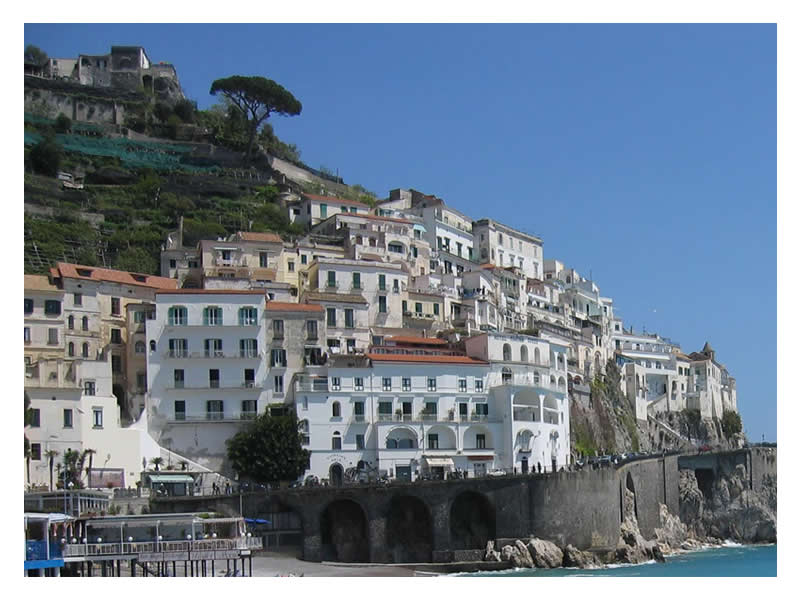 Caserta is the capital of the province of Caserta in the Campania region of Italy. It is an important agricultural, commercial and industrial comune and city. Caserta is located on the edge of the Campanian plain at the foot of the Campanian Subapennine mountain range. The city is best known for the Palace of Caserta. Caserta is the capital of the province of Caserta in the Campania region of Italy. It is an important agricultural, commercial and industrial comune and city. Caserta is located on the edge of the Campanian plain at the foot of the Campanian Subapennine mountain range. The city is best known for the Palace of Caserta.
Modern Caserta was established around the defensive tower built in Lombard times by Pando, Prince of Capua. Pando destroyed the original city around 863. The tower is now part of the Palazzo della Prefettura which was once the seat of the counts of Caserta, as well as a Royal residence. The original population moved from Casertavecchia (former bishopric seat) to the current site in the 16th century.
The city and vicinity were the property of the Acquaviva family, who, being pressed by huge debts, sold all the land to the royal family. The royal family then selected Caserta for the construction of their new palace, which, being in land was seen as more defensible than the previous palace fronting the Bay of Naples.
 What to taste: What to taste:
• A very popular cheese is the buffalo mozzarella, which is still produced with craftsmanship to confer its unique, soft texture. It can be made in different shapes: round, braided, knotted or as cherries. The water buffalo milk is used also to make butter, 'burrino', 'burrata', smoked 'provola' and fresh or dried ricotta. The 'caso conzato' is a cheese by the uniquely intense and aromatic flavor prepared following an extensive and plodding procedure.
• From the local farms comes also the excellent meat used to prepare cold cuts such as capicollo, prosciutto di Monte, pancetta tesa and the fillet of Vairano Patenora, a town famous also for the 'sausiccia', a sausage seasoned in special terracotta vases from the Caserta area.
• The Capuanella artichoke, tender and delicate, the tasty Roccamorfina porcini by the firm texture, the many varieties of apple Annurca, Limoncella and Sergente-, each with different characteristics, the Marmulegna, a delicious, golden plum, and the Roccamorfina chestnut are all delicacies that distinguish the local cuisine and recipes.
• The 'susamielli', crunchy flour, honey and walnut biscuits, the 'pigne', soft glazed sweets, a slice of 'serpentone' stuffed with honey, walnuts and natural flavors, or try a 'guanto caleno', an old, traditional recipe.
• The selection of wines is wide: a glass of Asprinio di Aversa, Falerno del Massico or Galluccio, all labeled DOC, will be the perfect complement for a traditional meal from this land.
 Cities & Towns: Cities & Towns:
 More info her on all the Municipalities, Cities, Towns and Villages - Caserta More info her on all the Municipalities, Cities, Towns and Villages - Caserta
 What to do: What to do:
• Matese Regional Park - A perfect balance between man and nature; this is the feeling when the visitor hikes the trails of this mangnicent area.
an extraordinary nature that can be explored hiking, trekking, horseback riding, mountain biking, cross-country skiing, rock and ice climbing.
• Roccamorfina Regional Park, with the extinct volcano whose ancient eruptions shaped this land, an ideal habitat for chestnut forests, vineyards and olive groves that blanket the expanse.
• At the mouth of the Garigliano River starts a trail that re-traces the ancient Domiziana road, along which the beach towns were established. The coast is composed of long, white beaches and dense pine forests, a perfect place for a vacation by the sea.
 Places to visit: Churches, Museums, Ruins, Piazzas, Fountains, Places to visit: Churches, Museums, Ruins, Piazzas, Fountains,
• Caserta's main attraction is its Royal Palace (listed as a UNESCO World Heritage Site). The palace was created in the 18th century by the Italian architect Luigi Vanvitelli as a Versailles-like residence ("Reggia") for the Bourbon kings of Naples and Sicily. It is one of the most visited monuments in the country. Inside are more than 1200 rooms, decorated in various styles. It has been the set for several famous movies such as Star Wars and Mission Impossible III. The park is 2 miles (3.2 km) long and contains many waterfalls, lakes and gardens, as well as a very famous English garden.
• Palazzo Vecchio ("Old Palace"), a construction of the 14th century renovated by Luigi Vanvitelli as provisional residence for the royal court.
• The Cathedral (18th century).
• The Aqueduct of Vanvitelli (18th century).
 Events: Events:
• Coming soon.
 Tours avaiable in the region: Tours avaiable in the region:
 Accomodations in close proximity: Hotels, Restorts, Holiday Houses, Condo Rentals, Farm Holidays (Agritourismo), Accomodations in close proximity: Hotels, Restorts, Holiday Houses, Condo Rentals, Farm Holidays (Agritourismo),
 Flights - Car Rentals - Cruises: Flights - Car Rentals - Cruises:
 Restaurants in close proximity: Restaurants in close proximity:
• (Add a restaurant review in the italian blog area of our website).
|
|
| |
Napoli
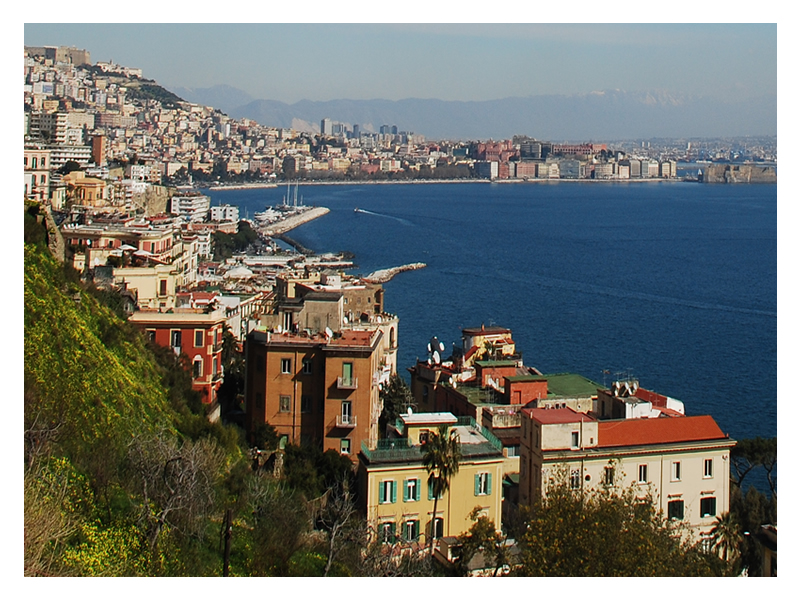 Naples is the capital of the region of Campania and of the province of Naples. The city is known for its rich history, art, culture and gastronomy, playing an important role throughout much of its existence; it is over 2,800 years old. Naples is located halfway between two volcanic areas, the volcano Mount Vesuvius and the Phlegraean Fields, sitting on the coast by the Gulf of Naples. Naples is the capital of the region of Campania and of the province of Naples. The city is known for its rich history, art, culture and gastronomy, playing an important role throughout much of its existence; it is over 2,800 years old. Naples is located halfway between two volcanic areas, the volcano Mount Vesuvius and the Phlegraean Fields, sitting on the coast by the Gulf of Naples.
Founded by the Ancient Greeks as "Νεάπολις", Neápolis (New City), it held an important role in Magna Graecia and then as part of the Roman Republic in the central province of the Empire. The city has seen a multitude of civilizations come and go, each leaving their mark and now the historic city centre is listed by UNESCO as a World Heritage Site. Naples was the capital city of a kingdom which bore its name from 1282 until 1816 in the form of the Kingdom of Naples, then in union with Sicily it was the capital of the Two Sicilies until the Italian unification.
The city proper has a population of around 1 million people, while the population of urban area is estimated by Eurostat to be 2.25 million. The Naples metropolitan area, according to different sources, is the second after the Milan metropolitan area (with 4.434.136 inhabitants according to SVIMEZ DATA or 4.996.084 according to CENSIS INSTITUTE) or the third (3.1 million inhabitants according to OECD) most populated metropolitan area in Italy.
The city is synonymous with pizza, which originated in the city. A strong part of Neapolitan culture which has had wide reaching effects is music, including the invention of the romantic guitar and the mandolin as well as strong contributions to opera and folk standards. There are popular characters and figures who have come to symbolise Naples; these include the patron saint of the city Januarius, Pulcinella, and the Sirens from the epic Greek poem the Odyssey.
 What to taste: What to taste:
• Pizza Margherita, a gastronomic marvel created to honor the Queen Margherita.
• Pizza Napoletana, thin in the middle, thick on the outside and seasoned with local tomatoes, mozzarella and basil.
• Spaghetti with mussel or clam sauce, risotto alla pescatora, moscardini affogati, grilled fish, fried anchovies, fried or stuffed calamari are a few recipes that employ the fresh fish caught and sold every day on the docks by the fishermen.
• As a dessert, a 'sfogliatella', crunchy pastry filled with ricotta, or some 'pastiera' (the most popular cake), or a rhum-filled babà.
• Sorrento's Limoncello.
• Local wines such as the Lacryma Christi of the Vesuvio DOC, or the Taurasia and the Greco di Tufo, all labeled DOCG.
 Cities & Towns: Cities & Towns:
 More info her on all the Municipalities, Cities, Towns and Villages - Napoli More info her on all the Municipalities, Cities, Towns and Villages - Napoli
 What to do: What to do:
• Water, sun and nature provide countless possibilities for water sports, above and under water. In Baia, one should not miss the chance for a tour of the underwater villas decorated with mosaic, fish farms and the ancient Roman port that comprise the Underwater Archeological Park.
• In the evening you can go to the bars, restaurants, pizzerias, clubs and discos remain open until late to give the visitor hours of joy and happiness.
• Just outside the city, in Torre del Greco, one will be able to buy jewels made with the precious red coral. Ercolano and Pompei provide a wide array of souvenirs reproducing the archeological finds and objects made with lava rock.
 Places to visit: Churches, Museums, Ruins, Piazzas, Fountains, Places to visit: Churches, Museums, Ruins, Piazzas, Fountains,
• Cappella del Tesoro di San Gennaro, the Chapel of St. Gennaro's Treasure, which holds masterpieces made with precious metals and the two vials containing the blood of the saint.
• Another place linked to the Saint Patron of Napoli is the Catacombe di San Gennaro with its frescos, mosaic and other valued artwork.
• The Palazzo Reale di Capodimonte, surrounded by a large park, hosts the Capodimonte Museum and National Galleries, an incredible collection of masterpieces by Tiziano, Raffaello, Correggio, Masaccio, Mantegna, Caravaggio and the Neapolitan masters
 Events: Events:
• In May the most important cultural event of the year takes place in Naples: May of the Monuments. The town reveal itself through exposition, meetings, exhibition, and special events. Many private exhibitions, churches and palaces, which are normally closed during the year, open their doors for the public just for the Maggio dei Monumenti. The entrance is partly free or free for many events.
• In September there is the Festival of Piedigrotta. It's being held in honour of the Madonna of Piedigrotta and was in the past the most important event of the year for the Neapolitans. The festival's highlights are a big concert where national and international singers will perform traditional songs in the Neapolitan dialect and the traditional procession in honour of the "canzone napoletana" with decorated wagons through the streets.
• Pizzafest in September - The Pizza has its own festival in the town where it was born: each evening there are music, theatre, cabaret, demonstrations, many surprises and naturally the Pizza napoletana!
• San Gennaro September 19th is the day of the patron of Naples St. Januarius (San Gennaro) and of the blood miracle is an important feast for Naples and the people celebrate it accordingly. The St. Januarius Cathedral (il Dumo di Napoli) is surrounded by stalls selling sweets, cobs and all kinds of curiosities and kitsch.
• Christmas in Naples - On December 8 is the Festa dell'Immacolata Concezione (holiday, the feast of the Immaculate Conception). Traditionally the Neapolitan begin the building of the crib.
On 6 January is the Epifania (Epiphany holiday, in informal talk called Befana too) and is the last holiday of the Christmas season: cribs, Christmas tree and Christmas lights are removed.
 Tours avaiable in the region: Tours avaiable in the region:
 Accomodations in close proximity: Hotels, Restorts, Holiday Houses, Condo Rentals, Farm Holidays (Agritourismo), Accomodations in close proximity: Hotels, Restorts, Holiday Houses, Condo Rentals, Farm Holidays (Agritourismo),
 Flights - Car Rentals - Cruises: Flights - Car Rentals - Cruises:
 Restaurants in close proximity: Restaurants in close proximity:
• Naples, Italy is full of wonderful and exciting places to eat out, with a wide choice of every kind of food imaginable. The many stylish locations in Naples and wide variety of superb, mouth-watering menus, often with an emphasis on fish, make Naples dining an enjoyable experience and many restaurants have spectacular views.
• Pasta combined with excellent local produce, such as fresh tomatoes, olive oil and rich, creamy Italian cheeses all combine to create the wonderful and delightful flavours associated with Italy. Naples is also renown for its splendid pizzas, which come in a wide range of flavours.
• For a romantic meal for two Naples is the place, the only problem is deciding where to go in the city, as there are so many restaurants in Naples to choose from. They are all wonderfull.
• (Add a restaurant review in the italian blog area of our website).
|
|
| |
Salerno
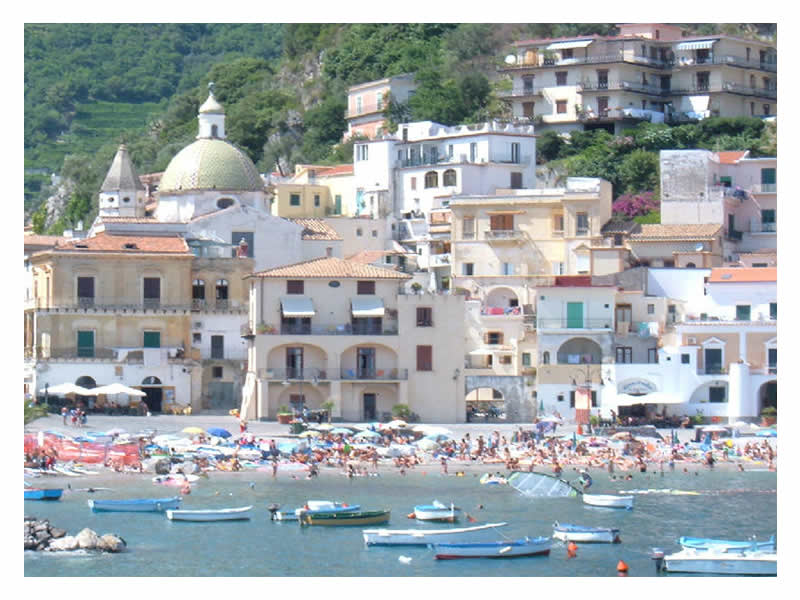 Salerno is a town in southern Italy, capital of the province of the same name, in the region of Campania. It is located on the Gulf of Salerno on the Tyrrhenian Sea. Salerno is a town in southern Italy, capital of the province of the same name, in the region of Campania. It is located on the Gulf of Salerno on the Tyrrhenian Sea.
Salerno is the main town in the Costiera Amalfitana (the "Amalfi Coast" on the Tyrrhenian, which includes the famous towns of Amalfi, Positano, and others) and is mostly known for its Schola Medica Salernitana (the first University of Medicine in the world).
In recent history the city hosted the King of Italy, who moved from Rome in 1943 after Italy negotiated a peace with the Allies in World War II. A brief so-called "government of the South" was then established in the town, that became the "Capital" of Italy for some months in 1944. Some of the Allied landings during Operation Avalanche (the invasion of Italy) occurred near Salerno. The city is situated at the north-western end of the plain of the Sele river, at the exact beginning of the Amalfi coast. The small river Irno crosses through the central section of Salerno.
The climate is Mediterranean, with a hot and relatively dry summer (23°C/74°F in August) and a rainy fall and winter (8°C/47°F in January). Usually there are nearly 1,000 mm of rain every year. The strong wind that comes from the mountains toward the Gulf of Salerno makes the city very windy (mainly in winter). But this fact gives Salerno a lot of sun because the clouds are quickly blown away, giving the advantage of being one of the most sunny towns of Italy.
 What to taste: What to taste:
• There are many fish-based dishes to sample: for example, spaghetti with clam sauce, fish soup, fried anchovies, swordfish rolls, octopus cooked with S. Marzano tomatoes, and mussel 'impepate'.
• The traditional way to cook meats is barbequed along with delicious vegetables.
• Cheeses include Provolone, pecorino, manteca del Cilento, scamorza, buffalo mozzarella and burrino are all still produced in the traditional way from centuries past.
• The Amalfi lemons are used to make the famous Limoncello and to prepare sweets and desserts such as the babà, whose dough is employed for the 'torta babarese' with whip cream and strawberries, the 'sospiri' and the lemon 'delizie'.
• Wine include the Costa d'Amalfi, Cilento, Castel S. Lorenzo, Gragnano, Sorrento and Lettere, are all protected by the DOC denomination.
 Cities & Towns: Cities & Towns:
 More info her on all the Municipalities, Cities, Towns and Villages - Salerno More info her on all the Municipalities, Cities, Towns and Villages - Salerno
 What to do: What to do:
• The area offers an open-air gym.The beauty of the sea is an irresistible call for those who love snorkeling, sea-watching and scuba diving.
• There is also Windsurfing, kitesurfing, surfing, sailing and canoeing.
• There are plenty of beaches and coves blessed with the scent of the maquis and a fresh breeze cradling the visitor.
• Trekking, hiking or mountain biking are a few ways to discover nature.
• Visit Amalfi, with its beautiful beachfront and where streets, alleys and stairs join through the town toward the Duomo, which is known for the magnificent mosaic façade.
• Visit Atrani, a picturesque village where the bright colors of the gardens are interspersed among the white houses.
• Hike the trails in Praiano through an unimaginable natural environment.
 Places to visit: Churches, Museums, Ruins, Piazzas, Fountains, Places to visit: Churches, Museums, Ruins, Piazzas, Fountains,
• The Spas of Contursi and Montesano sulla Marcellana offer treatments thanks to the healing properties of the mineral water.
• The Grotta dello Smeraldo, or Emerald Cave where you can see stalactites and stalagmites and the bright sunlight penetrating through the cracks of the rocks.
• Marina di Camerota, with its peculiar port, the coves and the wonderful caves
• The Temple of Hera, the oldest, the Temple of Neptune, the largest, and the Temple of Cerere, actually dedicated to Athena
• Certosa di Padula, one of the largest monasteries in the world.
 Events: Events:
• San Matteo Festival in September 21st - A celebration of the patron saint San Matteo (St. Matthew), whose remains are held in the city's impressive Duomo. The festival includes a procession where 6 large statues are carried through the town and an evening carnival along the seafront with rides, local food specialties and fireworks.
• Pizza Festival in July - Salerno holds an annual summer festival dedicated to Campania's most famous food – the Neapolitan style pizza. Featuring music and cultural events, this is a lively and fun local festival perfect for pizza lovers. The only challenge is picking your favorite!
 Tours avaiable in the region: Tours avaiable in the region:
 Accomodations in close proximity: Hotels, Restorts, Holiday Houses, Condo Rentals, Farm Holidays (Agritourismo), Accomodations in close proximity: Hotels, Restorts, Holiday Houses, Condo Rentals, Farm Holidays (Agritourismo),
 Flights - Car Rentals - Cruises: Flights - Car Rentals - Cruises:
 Restaurants in close proximity: Restaurants in close proximity:
• (Add a restaurant review in the italian blog area of our website).
|
Home | Advertising Information | Contact Us
Copyright ©2002 Italian Recipes Trinakria Development. All rights
reserved. |
 |
|
 |


 Information on Campania - Italy
Information on Campania - Italy Avellino is situated over the green valley crossed by the Sabato river and surrounded by the Pertenio, Avella and Picentini mountains. Today it is mostly a modern town because of the massive reconstructions after the frequent earthquakes. The chestnuts and nuts factories are of great importance as well as the wineries producing the famous Fiano di Avellino, Aglianico, Greco di Tufo and Taurasi wines. The beauty of the nature and the many archeological and cultural sites attract many tourists to the area.
Avellino is situated over the green valley crossed by the Sabato river and surrounded by the Pertenio, Avella and Picentini mountains. Today it is mostly a modern town because of the massive reconstructions after the frequent earthquakes. The chestnuts and nuts factories are of great importance as well as the wineries producing the famous Fiano di Avellino, Aglianico, Greco di Tufo and Taurasi wines. The beauty of the nature and the many archeological and cultural sites attract many tourists to the area.  Benevento , city (1991 pop. 62,561), capital of Benevento prov., in Campania, S Italy. It is a trade center for wine and tobacco. It is basically an impoverished area with little industry. A leading town of Samnium, Benevento became under the Romans an important trade center on the Appian Way.
Benevento , city (1991 pop. 62,561), capital of Benevento prov., in Campania, S Italy. It is a trade center for wine and tobacco. It is basically an impoverished area with little industry. A leading town of Samnium, Benevento became under the Romans an important trade center on the Appian Way.  Caserta is the capital of the province of Caserta in the Campania region of Italy. It is an important agricultural, commercial and industrial comune and city. Caserta is located on the edge of the Campanian plain at the foot of the Campanian Subapennine mountain range. The city is best known for the Palace of Caserta.
Caserta is the capital of the province of Caserta in the Campania region of Italy. It is an important agricultural, commercial and industrial comune and city. Caserta is located on the edge of the Campanian plain at the foot of the Campanian Subapennine mountain range. The city is best known for the Palace of Caserta. Naples is the capital of the region of Campania and of the province of Naples. The city is known for its rich history, art, culture and gastronomy, playing an important role throughout much of its existence; it is over 2,800 years old. Naples is located halfway between two volcanic areas, the volcano Mount Vesuvius and the Phlegraean Fields, sitting on the coast by the Gulf of Naples.
Naples is the capital of the region of Campania and of the province of Naples. The city is known for its rich history, art, culture and gastronomy, playing an important role throughout much of its existence; it is over 2,800 years old. Naples is located halfway between two volcanic areas, the volcano Mount Vesuvius and the Phlegraean Fields, sitting on the coast by the Gulf of Naples. Salerno is a town in southern Italy, capital of the province of the same name, in the region of Campania. It is located on the Gulf of Salerno on the Tyrrhenian Sea.
Salerno is a town in southern Italy, capital of the province of the same name, in the region of Campania. It is located on the Gulf of Salerno on the Tyrrhenian Sea.